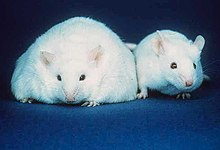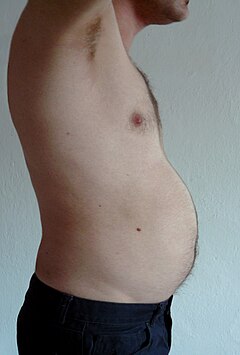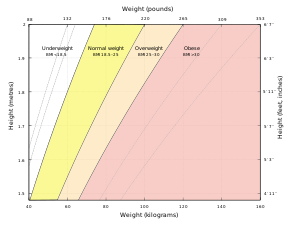| Adipose tissue | |
|---|---|

Adipose tissue is one of the main types of connective tissue.
| |
| Pronunciation | /ˈædɪˌpoʊs/ ( |
| Identifiers | |
| MeSH | D000273 |
| FMA | 20110 |
In biology, adipose tissue, body fat, or simply fat is a loose connective tissue composed mostly of adipocytes.[1] In addition to adipocytes, adipose tissue contains the stromal vascular fraction (SVF) of cells including preadipocytes, fibroblasts, vascular endothelial cells and a variety of immune cells such as adipose tissue macrophages. Adipose tissue is derived from preadipocytes. Its main role is to store energy in the form of lipids, although it also cushions and insulates the body. Far from being hormonally inert, adipose tissue has, in recent years, been recognized as a major endocrine organ, as it produces hormones such as leptin, estrogen, resistin, and cytokine (especially TNFα). The two types of adipose tissue are white adipose tissue (WAT), which stores energy, and brown adipose tissue (BAT), which generates body heat. The formation of adipose tissue appears to be controlled in part by the adipose gene. Adipose tissue – more specifically brown adipose tissue – was first identified by the Swiss naturalist Conrad Gessner in 1551.
Anatomical features
In humans, adipose tissue is located: beneath the skin (subcutaneous fat), around internal organs (visceral fat), in bone marrow (yellow bone marrow), intermuscular (Muscular system) and in the breast (breast tissue).
Adipose tissue is found in specific locations, which are referred to
as adipose depots. Apart from adipocytes, which comprise the highest
percentage of cells within adipose tissue, other cell types are present,
collectively termed stromal vascular fraction (SVF) of cells. SVF
includes preadipocytes, fibroblasts, adipose tissue macrophages, and endothelial cells. Adipose tissue contains many small blood vessels. In the integumentary system, which includes the skin, it accumulates in the deepest level, the subcutaneous
layer, providing insulation from heat and cold. Around organs, it
provides protective padding. However, its main function is to be a
reserve of lipids, which can be oxidised to meet the energy needs of the
body and to protect it from excess glucose by storing triglycerides
produced by the liver from sugars, although some evidence suggests that
most lipid synthesis from carbohydrates occurs in the adipose tissue
itself.[4]
Adipose depots in different parts of the body have different
biochemical profiles. Under normal conditions, it provides feedback for
hunger and diet to the brain.
Mice
Mice have eight major adipose depots, four of which are within the abdominal cavity. The paired gonadal depots are attached to the uterus and ovaries in females and the epididymis and testes in males; the paired retroperitoneal depots are found along the dorsal wall of the abdomen,
surrounding the kidney, and, when massive, extend into the pelvis. The
mesenteric depot forms a glue-like web that supports the intestines and the omental depot (which originates near the stomach and spleen) and - when massive - extends into the ventral abdomen. Both the mesenteric and omental depots incorporate much lymphoid tissue as lymph nodes and milky spots, respectively.
The two superficial depots are the paired inguinal depots, which
are found anterior to the upper segment of the hind limbs (underneath
the skin) and the subscapular depots, paired medial mixtures of brown
adipose tissue adjacent to regions of white adipose tissue, which are
found under the skin
between the dorsal crests of the scapulae. The layer of brown adipose
tissue in this depot is often covered by a "frosting" of white adipose
tissue; sometimes these two types of fat (brown and white) are hard to
distinguish. The inguinal depots enclose the inguinal group of lymph
nodes. Minor depots include the pericardial,
which surrounds the heart, and the paired popliteal depots, between the
major muscles behind the knees, each containing one large lymph node. Of all the depots in the mouse, the gonadal depots are the largest and the most easily dissected, comprising about 30% of dissectible fat.
Obesity
In an obese person, excess adipose tissue hanging downward from the abdomen is referred to as a panniculus.
A panniculus complicates surgery of the morbidly obese individual. It
may remain as a literal "apron of skin" if a severely obese person
quickly loses large amounts of fat (a common result of gastric bypass surgery). Obesity is treated through exercise, diet, and behavioral therapy. Reconstructive surgery is one method of treatment.
Visceral fat
Abdominal obesity in men - beer belly
Visceral fat or abdominal fat (also known as organ fat or intra-abdominal fat) is located inside the abdominal cavity, packed between the organs (stomach, liver, intestines, kidneys, etc.). Visceral fat is different from subcutaneous fat underneath the skin, and intramuscular fat interspersed in skeletal muscles. Fat in the lower body, as in thighs and buttocks, is subcutaneous and is not consistently spaced tissue, whereas fat in the abdomen is mostly visceral and semi-fluid. Visceral fat is composed of several adipose depots, including mesenteric, epididymal white adipose tissue (EWAT), and perirenal depots. Visceral fat is often expressed in terms of its area in cm2 (VFA, visceral fat area).
An excess of visceral fat is known as central obesity, or "belly fat", in which the abdomen protrudes excessively. New developments such as the Body Volume Index (BVI) are specifically designed to measure abdominal volume and abdominal fat. Excess visceral fat is also linked to type 2 diabetes, insulin resistance, inflammatory diseases, and other obesity-related diseases. Likewise, the accumulation of neck fat (or cervical adipose tissue) has been shown to be associated with mortality. Several studies have suggested that visceral fat can be predicted from simple anthropometric measures, and predicts mortality more accurately than body mass index or waist circumference.
Men are more likely to have fat stored in the abdomen due to sex hormone differences. Female sex hormone causes fat to be stored in the buttocks, thighs, and hips in women. When women reach menopause and the estrogen produced by the ovaries declines, fat migrates from the buttocks, hips and thighs to the waist; later fat is stored in the abdomen.
High-intensity exercise is one way to effectively reduce total abdominal fat. One study suggests at least 10 MET-hours per week of aerobic exercise is required for visceral fat reduction.
Epicardial fat
Epicardial
adipose tissue (EAT) is a particular form of visceral fat deposited
around the heart and found to be a metabolically active organ that
generates various bioactive molecules, which might significantly affect cardiac function. Marked component differences have been observed in comparing EAT with subcutaneous fat, suggesting a depot specific impact of stored fatty acids on adipocyte function and metabolism.
Subcutaneous fat
Micro-anatomy of subcutaneous fat
Most of the remaining nonvisceral fat is found just below the skin in a region called the hypodermis. This subcutaneous fat is not related to many of the classic obesity-related pathologies, such as heart disease, cancer, and stroke, and some evidence even suggests it might be protective.
The typically female (or gynecoid) pattern of body fat distribution
around the hips, thighs, and buttocks is subcutaneous fat, and therefore
poses less of a health risk compared to visceral fat.
Like all other fat organs, subcutaneous fat is an active part of the endocrine system, secreting the hormones leptin and resistin.\
The relationship between the subcutaneous adipose layer and total
body fat in a person is often modelled by using regression equations.
The most popular of these equations was formed by Durnin and Wormersley,
who rigorously tested many types of skinfold, and, as a result, created
two formulae to calculate the body density of both men and women. These
equations present an inverse correlation between skinfolds and body
density—as the sum of skinfolds increases, the body density decreases.
Factors such as sex, age, population size or other variables may make the equations invalid and unusable, and, as of 2012,
Durnin and Wormersley's equations remain only estimates of a person's
true level of fatness. New formulae are still being created.
Marrow fat
Marrow fat, also known as marrow adipose tissue (MAT),
is a poorly understood adipose depot that resides in the bone and is
interspersed with hematopoietic cells as well as bony elements. The
adipocytes in this depot are derived from mesenchymal stem cells (MSC)
which can give rise to fat cells, bone cells as well as other cell
types. The fact that MAT increases in the setting of calorie
restriction/ anorexia is a feature that distinguishes this depot from
other fat depots.
The exercise regulation of marrow fat suggests that it bears some
physiologic similarity to other white adipose depots. Moreover,
increased MAT in obesity further suggests a similarity to white fat
depots.
Ectopic fat
Ectopic fat is the storage of triglycerides in tissues other than adipose tissue, that are supposed to contain only small amounts of fat, such as the liver, skeletal muscle, heart, and pancreas.
This can interfere with cellular functions and hence organ function and
is associated with insulin resistance in type-2 diabetes. It is stored in relatively high amounts around the organs of the abdominal cavity, but is not to be confused with visceral fat.
The specific cause for the accumulation of ectopic fat is
unknown. The cause is likely a combination of genetic, environmental,
and behavioral factors that are involved in excess energy intake and
decreased physical activity. Substantial weight loss can reduce ectopic
fat stores in all organs and this is associated with an improvement of
the function of that organ.
In the latter case, non-invasive weight loss interventions like
diet or exercise can decrease ectopic fat (particularly in heart and
liver) in overweight or obese children and adults.
Physiology
Free fatty acids (FFAs) are liberated from lipoproteins by lipoprotein lipase (LPL) and enter the adipocyte, where they are reassembled into triglycerides by esterifying them onto glycerol. Human fat tissue contains about 87% lipids.
There is a constant flux of FFAs entering and leaving adipose
tissue. The net direction of this flux is controlled by insulin and
leptin—if insulin is elevated, then there is a net inward flux of FFA,
and only when insulin is low can FFA leave adipose tissue. Insulin
secretion is stimulated by high blood sugar, which results from
consuming carbohydrates.
In humans, lipolysis (hydrolysis of triglycerides into free fatty
acids) is controlled through the balanced control of lipolytic B-adrenergic receptors and a2A-adrenergic receptor-mediated antilipolysis.
Fat cells have an important physiological role in maintaining triglyceride and free fatty acid levels, as well as determining insulin resistance. Abdominal fat has a different metabolic profile—being more prone to induce insulin resistance. This explains to a large degree why central obesity is a marker of impaired glucose tolerance and is an independent risk factor for cardiovascular disease (even in the absence of diabetes mellitus and hypertension). Studies of female monkeys at Wake Forest University (2009) discovered that individuals suffering from higher stress
have higher levels of visceral fat in their bodies. This suggests a
possible cause-and-effect link between the two, wherein stress promotes
the accumulation of visceral fat, which in turn causes hormonal and
metabolic changes that contribute to heart disease and other health
problems.
Recent advances in biotechnology have allowed for the harvesting of adult stem cells
from adipose tissue, allowing stimulation of tissue regrowth using a
patient's own cells. In addition, adipose-derived stem cells from both
human and animals reportedly can be efficiently reprogrammed into induced pluripotent stem cells without the need for feeder cells.
The use of a patient's own cells reduces the chance of tissue rejection
and avoids ethical issues associated with the use of human embryonic stem cells.
A growing body of evidence also suggests that different fat depots
(i.e. abdominal, omental, pericardial) yield adipose-derived stem cells
with different characteristics. These depot-dependent features include proliferation rate, immunophenotype, differentiation potential, gene expression, as well as sensitivity to hypoxic culture conditions. Oxygen levels seem to play an important role on the metabolism and in general the function of adipose-derived stem cells.
Adipose tissue is a major peripheral source of aromatase in both males and females, contributing to the production of estradiol.
Adipose derived hormones include:
- Adiponectin
- Resistin
- Plasminogen activator inhibitor-1 (PAI-1)
- TNFα
- IL-6
- Leptin
- Estradiol (E2)
Adipose tissues also secrete a type of cytokines (cell-to-cell signalling proteins) called adipokines
(adipose cytokines), which play a role in obesity-associated
complications. Perivascular adipose tissue releases adipokines such as
adiponectin that affect the contractile function of the vessels that
they surround.
Brown fat
Brown fat or brown adipose tissue (BAT) is a specialized form of adipose tissue important for adaptive thermogenesis in humans and other mammals. BAT can generate heat by "uncoupling" the respiratory chain of oxidative phosphorylation within mitochondria through tissue-specific expression of uncoupling protein 1 (UCP1). BAT is primarily located around the neck and large blood vessels of the thorax, where may effectively act in heat exchange. BAT is robustly activated upon cold exposure by the release of catecholamines from sympathetic nerves that results in UCP1 activation. BAT activation may also occur in response to overfeeding. UCP1 activity is stimulated by long chain fatty acids that are produced subsequent to β-adrenergic receptor activation. UCP1 is proposed to function as a fatty acid proton symporter, although the exact mechanism has yet to be elucidated. In contrast, UCP1 is inhibited by ATP, ADP, and GTP.
Attempts to simulate this process pharmacologically have so far been unsuccessful. Techniques to manipulate the differentiation of "brown fat" could become a mechanism for weight loss therapy in the future, encouraging the growth of tissue with this specialized metabolism without inducing it in other organs.
Until recently, brown adipose tissue was thought to be primarily
limited to infants in humans, but new evidence has now overturned that
belief. Metabolically active tissue with temperature responses similar
to brown adipose was first reported in the neck and trunk of some human
adults in 2007, and the presence of brown adipose in human adults was later verified histologically in the same anatomical regions.
Beige fat and WAT browning
Morphology of three different classes of adipocytes
Browning of WAT, also referred to as "beiging", occurs when
adipocytes within WAT depots develop features of BAT. Beige adipocytes
take on a multilocular appearance (containing several lipid droplets)
and increase expression of uncoupling protein 1 (UCP1). In doing so, these normally energy-storing adipocytes become energy-releasing adipocytes.
The calorie-burning capacity of brown and beige fat has been
extensively studied as research efforts focus on therapies targeted to
treat obesity and diabetes. The drug 2,4-dinitrophenol,
which also acts as a chemical uncoupler similarly to UCP1, was used for
weight loss in the 1930s. However, it was quickly discontinued when
excessive dosing led to adverse side effects including hyperthermia and
death.
β3 agonists, like CL316,243, have also been developed and tested in
humans. However, the use of such drugs has proven largely unsuccessful
due to several challenges, including varying species receptor
specificity and poor oral bioavailability.
Cold is a primary regulator of BAT processes and induces WAT
browning. Browning in response to chronic cold exposure has been well
documented and is a reversible process. A study in mice demonstrated
that cold-induced browning can be completely reversed in 21 days, with
measurable decreases in UCP1 seen within a 24-hour period.
A study by Rosenwald et al. revealed that when the animals are
re-exposed to a cold environment, the same adipocytes will adopt a beige
phenotype, suggesting that beige adipocytes are retained.
Transcriptional regulators, as well as a growing number of other
factors, regulate the induction of beige fat. Four regulators of
transcription are central to WAT browning and serve as targets for many
of the molecules known to influence this process. These include peroxisome proliferator-activated receptor gamma (PPARγ), PR domain containing 16 (PRDM16), peroxisome proliferator-activated receptor gamma coactivator 1 alpha (PGC-1α), and Early B-Cell Factor-2 (EBF2).
The list of molecules that influence browning has grown in direct
proportion to the popularity of this topic and is constantly evolving
as more knowledge is acquired. Among these molecules are irisin and fibroblast growth factor 21 (FGF21),
which have been well-studied and are believed to be important
regulators of browning. Irisin is secreted from muscle in response to
exercise and has been shown to increase browning by acting on beige
preadipocytes.
FGF21, a hormone secreted mainly by the liver, has garnered a great
deal of interest after being identified as a potent stimulator of
glucose uptake and a browning regulator through its effects on PGC-1α. It is increased in BAT during cold exposure and is thought to aid in resistance to diet-induced obesity
FGF21 may also be secreted in response to exercise and a low protein
diet, although the latter has not been thoroughly investigated.
Data from these studies suggest that environmental factors like diet
and exercise may be important mediators of browning. In mice, it was
found that beiging can occur through the production of
methionine-enkephalin peptides by type 2 innate lymphoid cells in response to interleukin 33.
Genomics and bioinformatics tools to study browning
Due
to the complex nature of adipose tissue and a growing list of browning
regulatory molecules, great potential exists for the use of bioinformatics
tools to improve study within this field. Studies of WAT browning have
greatly benefited from advances in these techniques, as beige fat is
rapidly gaining popularity as a therapeutic target for the treatment of
obesity and diabetes.
DNA microarray
is a bioinformatics tool used to quantify expression levels of various
genes simultaneously, and has been used extensively in the study of
adipose tissue. One such study used microarray analysis in conjunction
with Ingenuity IPA software to look at changes in WAT and BAT gene
expression when mice were exposed to temperatures of 28 and 6 °C.
The most significantly up- and downregulated genes were then identified
and used for analysis of differentially expressed pathways. It was
discovered that many of the pathways upregulated in WAT after cold
exposure are also highly expressed in BAT, such as oxidative phosphorylation, fatty acid metabolism, and pyruvate metabolism.[74]
This suggests that some of the adipocytes switched to a beige phenotype
at 6 °C. Mössenböck et al. also used microarray analysis to demonstrate
that insulin deficiency inhibits the differentiation of beige adipocytes but does not disturb their capacity for browning. These two studies demonstrate the potential for the use of microarray in the study of WAT browning.
RNA sequencing (RNA-Seq)
is a powerful computational tool that allows for the quantification of
RNA expression for all genes within a sample. Incorporating RNA-Seq into
browning studies is of great value, as it offers better specificity,
sensitivity, and a more comprehensive overview of gene expression than
other methods. RNA-Seq has been used in both human and mouse studies in
an attempt characterize beige adipocytes according to their gene
expression profiles and to identify potential therapeutic molecules that
may induce the beige phenotype. One such study used RNA-Seq to compare
gene expression profiles of WAT from wild-type (WT)
mice and those overexpressing Early B-Cell Factor-2 (EBF2). WAT from
the transgenic animals exhibited a brown fat gene program and had
decreased WAT specific gene expression compared to the WT mice. Thus, EBF2 has been identified as a potential therapeutic molecule to induce beiging.
Chromatin immunoprecipitation with sequencing (ChIP-seq) is a method used to identify protein binding sites on DNA and assess histone modifications. This tool has enabled examination of epigenetic
regulation of browning and helps elucidate the mechanisms by which
protein-DNA interactions stimulate the differentiation of beige
adipocytes. Studies observing the chromatin landscapes of beige
adipocytes have found that adipogenesis of these cells results from the
formation of cell specific chromatin landscapes, which regulate the
transcriptional program and, ultimately, control differentiation. Using
ChIP-seq in conjunction with other tools, recent studies have identified
over 30 transcriptional and epigenetic factors that influence beige
adipocyte development.
Genetics
The thrifty gene hypothesis
(also called the famine hypothesis) states that in some populations the
body would be more efficient at retaining fat in times of plenty,
thereby endowing greater resistance to starvation in times of food
scarcity. This hypothesis, originally advanced in the context of glucose
metabolism and insulin resistance, has been discredited by physical
anthropologists, physiologists, and the original proponent of the idea
himself with respect to that context, although according to its
developer it remains "as viable as when [it was] first advanced" in
other contexts.
In 1995, Jeffrey Friedman, in his residency at the Rockefeller University, together with Rudolph Leibel, Douglas Coleman et al. discovered the protein leptin that the genetically obese mouse lacked. Leptin is produced in the white adipose tissue and signals to the hypothalamus.
When leptin levels drop, the body interprets this as a loss of energy,
and hunger increases. Mice lacking this protein eat until they are four
times their normal size.
Leptin, however, plays a different role in diet-induced obesity
in rodents and humans. Because adipocytes produce leptin, leptin levels
are elevated in the obese. However, hunger remains, and—when leptin
levels drop due to weight loss—hunger increases. The drop of leptin is
better viewed as a starvation signal than the rise of leptin as a satiety signal. However, elevated leptin in obesity is known as leptin resistance.
The changes that occur in the hypothalamus to result in leptin
resistance in obesity are currently the focus of obesity research.
Gene defects in the leptin gene (ob) are rare in human obesity. As of July 2010, only 14 individuals from five families have been identified worldwide who carry a mutated ob
gene (one of which was the first ever identified cause of genetic
obesity in humans)—two families of Pakistani origin living in the UK,
one family living in Turkey, one in Egypt, and one in Austria—and two other families have been found that carry a mutated ob receptor.
Others have been identified as genetically partially deficient in
leptin, and, in these individuals, leptin levels on the low end of the
normal range can predict obesity.
Several mutations of genes involving the melanocortins (used in brain signaling associated with appetite) and their receptors have also been identified as causing obesity in a larger portion of the population than leptin mutations.
Physical properties
Adipose tissue has a density of ~0.9 g/ml. Thus, a person with more adipose tissue will float more easily than a person of the same weight with more muscular tissue, since muscular tissue has a density of 1.06 g/ml.
Body fat meter
A body fat meter is a widely available tool used to measure
the percentage of fat in the human body. Different meters use various
methods to determine the body fat to weight ratio. They tend to under-read body fat percentage.
In contrast with clinical tools, one relatively inexpensive type of body fat meter uses the principle of bioelectrical impedance analysis (BIA) in order to determine an individual's body fat percentage. To achieve this, the meter passes a small, harmless, electric current through the body and measures the resistance,
then uses information on the person's weight, height, age, and sex to
calculate an approximate value for the person's body fat percentage. The
calculation measures the total volume of water in the body (lean tissue
and muscle contain a higher percentage of water than fat), and
estimates the percentage of fat based on this information. The result
can fluctuate several percentage points depending on what has been eaten
and how much water has been drunk before the analysis. Before bioelectrical impedance analysis machines were developed, there were many different ways in analyzing body composition such as skin fold methods using calipers, underwater weighing, whole body air displacement plethysmography (ADP) and DXA.
Animal studies
Within the fat (adipose) tissue of CCR2 deficient mice, there is an increased number of eosinophils, greater alternative Macrophage activation, and a propensity towards type 2 cytokine expression. Furthermore, this effect was exaggerated when the mice became obese from a high fat diet.















